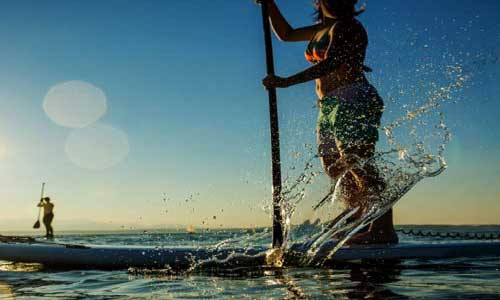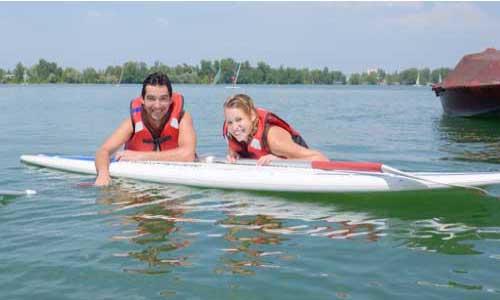Learn How To Stand Up Paddle Board

Stand Up Paddle Boarding (SUP) can be one of the most amazing experiences on the water. Since you stand at full height it allows you to get a beautiful vantage point to look down at what is under the water as well as what is across the horizon. This is an experience you will not get anywhere else.
Before you get out on the water there are a few things you must know.
- How to pick out all the correct gear. You will need to have the proper clothing, board, paddle, etc.
- How to stand up and launch your paddle board so you don’t fall before you start
- Proper paddling techniques to ensure you get to where you are wanting to go
- A few more tips to make your first time an enjoyable time
Table of Contents
Stand Up Paddle Board Essentials
Stand Up Paddle Board Clothing
Proper clothing is something that often gets overlooked by beginners. During the summer months where it is warm outside, most people choose to wear a combination of a swimsuit, board shorts, and a short or long sleeve rash guard to protect themselves from the sun. During colder conditions, where you might need to prevent hypothermia, a wetsuit or dry suit is required.
Stand Up Paddle Board (SUP)
Stand Up Paddle Boards come in all shapes and sizes. SUPs are much thicker than an average surfboard and normally range from 8 to 12 feet in length, 28 to 32 inches in width, and 4 to 5 inches thick. Most beginners tend to prefer a paddle board that is wider, longer, and thicker because this gives you the most stability to learn the basic techniques. Once you gain experience and get comfortable with your techniques then you can move to a shorter and skinnier board. If you need more information, check out our article on how to choose a stand up paddle board.
Stand Up Paddle Board Paddles
Stand Up Paddles are similar to a canoe paddle except a little more stretched out. They come in all kinds of different variations. For instance, construction materials come in plastic, aluminum, wood, and carbon fiber and all varieties of handles, blades, and shaft shapes. It is recommended that the paddle you choose to use with your paddle board should always be 6 to 10 inches above the height of you, the paddler. The longer side of your paddle is meant to be used for flat water and the shorter side is used for the surf. The blades of your paddle is typically bent at a slight angle to the shaft to allow a more forward reach when taking strokes.
Stand Up Paddle Board Leash
A Stand Up Paddle Board leash is a Velcro strap you put around your ankle to keep your paddle board attached to you. Leashes are available in a variety of sizes and the way you pick the correct leash is by choosing one that is around the same size or slightly smaller than your paddle board. A leash is necessary because in case of a fall or a current sweeps you off your board, your board is always with you.
PFD (Personal Flotation Device)
If you intend to use a paddle board outside of a surf or swimming area then the U.S. Coast Guard requires you to have a USCG-approved life vest on board. It is not required for adults to wear it but children are required to wear the PFD. For more information, check out this guide on choosing the right PDF.
Transporting Your Paddle Board
Before you can get out on the water, you need to learn how to transport your paddle board.
- Board Handles – Boards have a small handle installed at the center point so you can carry it to and from the water.
- Car Racks – When traveling to your water location, a paddle board is too long to fit inside a vehicle so car racks are a must. SUPs can be strapped down on any vehicle with the use of car racks.
SUP Basic Techniques
There are a few techniques that are important for beginners to know before going out on the water. Those techniques are:
Standing Up On Your Paddle Board
Practice these techniques in shallow water just deep enough that the fin does not touch:
- Stand next to the board and hold it by its edges while working your way onto the board in a kneeling position right behind the center of the board
- To help stabilize yourself, put a hand on each side of the board and one foot at a time move them up to where your knees are
- Slowly, raise your chest until it is vertical then extend one leg at a time until you are standing
- To keep your balance, have your feet hip-width apart and your knees slightly bent
Falling And Getting Back Up
No matter what level of expertise you have you are going to fall off your board at some point. Because of this, you need to know how to protect yourself from injury when falling. Below are key tips on how to properly fall and get back on your board.
Falling Off Your Paddle Board
- When you feel yourself falling, aim to land into the water and not on your board. This will protect from injury
- Try to hold onto your paddle so you do not lose it. In the case you do get separated from your paddle, retrieve your board first then use your free arm to swim towards your paddle
SUP Paddle Strokes

Now that you are on your paddle board, it is time to start paddling. There are 3 different strokes that a paddler needs to know, forward stroke, reverse stroke, and sweep stroke. Below are more details below:
Forward Stroke
- With this stroke, you are going to get your power from your shoulder, torso, and top hand
- Put your paddle in the water approximately 2 feet in front of you
- Move the paddle through the water back to your ankle while also twisting your torso. When doing this push down on your paddle grip with your top hand instead of pulling backward with your bottom hand
- Lift the paddle out of the water and repeat the previous 2 steps
- To go in a straight line you will want to alternate paddling on each side. This does not mean switching sides every stroke because you can alternate after every 3 or 4 strokes
Reverse Stroke
- This stroke is used for slowing down, stopping, and turning and is basically the opposite of the forward stroke
- Reach the paddle behind you and place it in the water near the tail of your paddle board
- Like the forward stroke, twist your torso and pull with your top hand rather than pulling the paddle with your arms
- When doing the reverse stroke you will turn the nose of your board towards the direction of the side of the board you are paddling on
Turning Sweep Stroke
- This stroke will turn you when you are standing still or moving
- Whichever side you are paddling on, turn that shoulder forward. For example, if you are paddling on the right side then turn your right shoulder forward
- Place your paddle in the water all the way over the blade
- Sweep the paddle away from the board to make a semi-circle movement from the nose of your board to the tail by using the leverage of your legs and torso
- If you are paddling on the right side of the board then you will turn left and vice versa
Tips For Your First Time On A SUP

Before taking your first trip out onto the water, there are a few things you should do to ensure that you have an amazing experience.
- Choose a location that has a calm body of water, like a lake or pond. Also, be sure there are not a lot of people out on the water and there are no obstacles like boats or buoys
- Find a location that has a shoreline that allows you to easily wade into the water for a better way to launch your SUP
- Choose a day that has little to no wind but if it is windy then be sure to go into the wind on your way out so it is blowing against your back on the way in that way you get a boost when you are tired
- Go with a friend that way you both can keep an eye out on each other
- Wear your PFD
- Do not push yourself. If you start to get tired, return to the shore.
